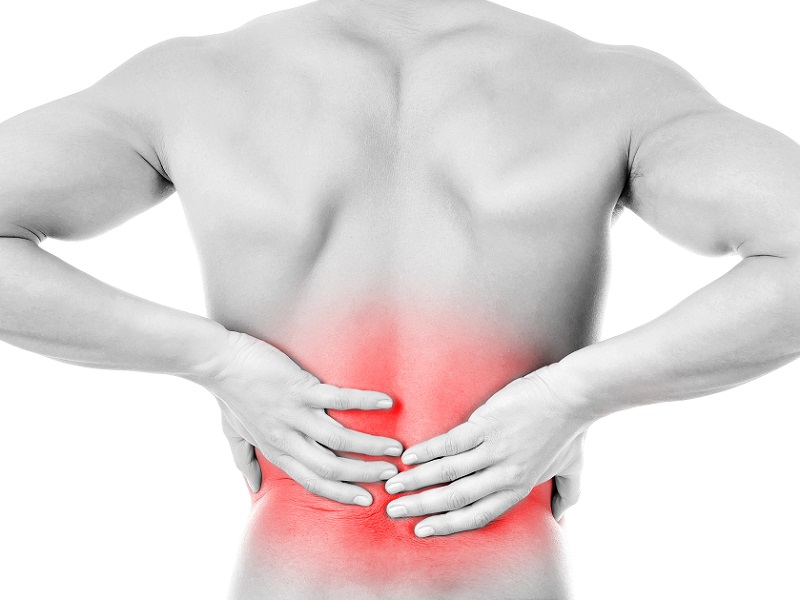One of the most prevalent causes of medical appointments and missed work is lower back pain discomfort. The discomfort may first manifest as a result of a traumatic event, such as dropping a large item, or it may just become more noticeable as we become older. When you return to exercise after even a little layoff, you may have lower back discomfort from the intensity of your activity.
As a rule, there are two types of low back pain:
Acute back discomfort usually subsides within a few weeks, and there is no permanent impairment of function.
Lower back discomfort that lasts for more than 12 weeks is considered chronic.
There are effective treatments available for both acute and chronic lower back pain. Below, you’ll find information on how to cure and eliminate lower back pain with the use of both conventional medicine and tried-and-true home remedies.
1: Stand tall and confident.
Pay attention to your hip and spine muscles and joints if you wish to eliminate lower back discomfort with minimum effort. Avoid back pain by keeping an eye on your posture and making any necessary adjustments to your neck, shoulders, and back alignment.
Back pain and other symptoms may be exacerbated by sitting or standing in an unsupported position all day.
Sitting for lengthy periods of time increases pressure on your spinal discs, which may lead to pain in your hips and knees. To lessen the strain on your discs, try working at a standing desk or getting up and going for short walks once each hour.
Rotating activities to give the muscles and joints a rest is another strategy for avoiding exhaustion that may contribute to lower back discomfort.
For instance, if you’ve been standing for quite some time, you may want to consider sitting down for a while. Modifying even one aspect of your routine might alleviate unnecessary pressure on your body’s joints and muscles.
2: Exercise
Intense physical activity may seem counterproductive when you’re trying to alleviate lower back pain. However, if you choose the correct sorts of motion, it may be helpful. Exercises like sit-ups, toe touches, and leg lifts may aggravate back discomfort in persons who have bulging discs. Backward bending or even rising up may cause pain in those with spinal arthritis.
In the case of lower back pain, exercise has been demonstrated to be helpful, especially for people with chronic pain.
However, the sort of exercises that will be most effective in relieving your lower back pain may depend on a number of variables, such as:
For how long have you been experiencing low back pain?
To what age are you?
how fit you are
Back problems that have been officially diagnosed
As an example, if you suffer from back discomfort, you might benefit from doing some therapeutic exercises. They aid in restoring deficiencies that might be causing symptoms by addressing bad movement patterns or strengthening weaker muscles.
Many physical therapists, for instance, recommend McKenzie exercises for the efficient rehabilitation of acute lower back pain.
The underlying principle of these routines is that proper spinal alignment helps alleviate pain.
Lower back discomfort may be alleviated with even a little exercise, like walking. Those who suffer from persistent lower back pain may find that a walking program provides the same relief as more intensive forms of exercise therapy.
3: Use heat or cold therapy
Using heat or ice to treat your lower back discomfort is another option. In addition to being effective, this treatment plan is also low-cost and simple to apply. These are tried-and-true methods for immediately reducing lower back discomfort.
It’s important to assess the source of the discomfort before deciding whether to use a hot or cold compress. Back pain may be treated with a mix of cold and heat for acute pain, while moderate heat applied continuously may be necessary for persistent pain.
If you want to go from hot to cold, you should apply heat for 10 to 15 minutes, then ice for 10 to 15 minutes, every two to three hours.
See below for advice on how to use heat or cold treatment to alleviate lower back discomfort.
Heat therapy
Apply heat for 10–15 minutes at a time
Instead of using dry heat, like heating pads, try using wet heat, like hot packs, baths, or showers.
All-day heat wrap
These lightweight heating wraps are unobtrusive and comfortable enough to use all day long. Pharmacy shelves should have these.
Electric heating pad
It’s important to stay awake when using an electric heating pad. When using a heating pad, make sure the heat is moderate to medium and never high. Protect yourself against burns by taking these precautions.
Cold therapy
Frozen towel
Saturate the towel in cold water and wring it out completely. When you’re done, fold the towel, seal it in a plastic bag, and pop it in the freezer for 15 minutes. Take the frozen towel out of the bag and put it where your lower back hurts.
Ice pack
Prepare a cooler by placing 1 pound of ice in a plastic bag and adding just enough water to cover the ice. Squeeze the air out and zip up the bag. Wrap the bag in a damp cloth and apply it to the sore spot.
A paper cup filled with ice
To make ice, fill a paper cup halfway with water and place it in the freezer. If you’re experiencing pain in your lower back, do this: peel aside a section of the paper to reveal the ice, then massage it gently over your lower back for 3-5 minutes.
4: Superior restful sleep
Feeling less lower back pain throughout the day is one of the many benefits of getting a good night’s sleep. A good night’s sleep may do wonders for your mood and general well-being. If your lower back suffers at night, it might be related to the way you sleep, which could lead to a restless night. If your spine is not in a neutral posture while you sleep, you may wake up with lower back aches.
Use these three strategies to improve your nightly slumber.
Shift the way you snooze
One technique to alleviate lower back discomfort is to ensure the pressure is distributed evenly throughout the spine. You may either lay on your back with a cushion between your knees to keep your weight distributed properly or prop up your lower back with a pillow. If you sleep on your side, consider bringing your knees in closer to your chest and switching sides often.
Stomach sleeping should be avoided since it adds unnecessary pressure on the spine. If you find yourself unable to sleep in any other position, try putting a pillow under your stomach to reduce pressure on your spine.
There is no ideal sleeping position that works for everyone since people are all different. Locate the one that suits you best.
5: Boost your health with a better diet.
The chance of having low back pain may also be increased by one’s diet. Given that inflammation is linked to back pain, a low-inflammatory diet is something you may want to think about trying.
Consuming large quantities of refined carbohydrates, processed sweets, and red meat while eating little fruits and vegetables is an example of a pro-inflammatory diet.
These inflammatory meals are also often very calorically dense, which may contribute to the development of obesity. Low back discomfort is highly associated with being overweight.
Also, cut down on or avoid fried meals.
Canola oil, maize oil, sunflower oil, and soybean oil are all examples of vegetable oils.
food items high in refined carbs, such as certain morning cereals, pastries, ice cream, baked goods, white bread, white spaghetti, and snack foods
Beverages with a lot of added sugar
Regular use of anti-inflammatory foods may raise blood levels of anti-inflammatory compounds. These assist alleviate back pain by preventing inflammatory responses in the body.
Here are some examples of foods that contain these anti-inflammatory substances:
Canned and fresh seafood such as sardines, tuna, salmon, mackerel, anchovies, and shellfish
Berries, strawberries, and raspberries, to name a few
spices and herbs like thyme, garlic, cloves, oregano, ginger, rosemary, and cinnamon
Greens with a lot of shade
Legumes/pulses
Various Seeds and Nuts
A healthy dose of olives and oil
Remember that there may not be a single anti-inflammatory meal. One’s best bet is to eat a variety of fresh, wholesome meals together.
When shopping for ‘healthy’ or ‘whole’ packaged goods, it’s important to pay attention to the ingredients as well. The anti-inflammatory effects of the diet might be diminished if it has extra sweets or fats.
In this paragraph, we will discuss the many pain relievers available. Pregabalin 300mg pills may help alleviate some of the discomfort caused by diabetic neuropathy. Those with nerve injury are also encouraged to take Pregalin 50mg. Both medications are designed to relieve neuropathy-related suffering. Both regular Pain O Soma and the stronger Pain O Soma 500mg include carisoprodol, making them effective for relieving excruciating pain in the bones and joints. Visit buysafemg.com if you’ve been experiencing discomfort and have exhausted all other possible medical avenues without relief.
6: Get some sturdy footwear
Have you ever considered that your shoes may be the culprit behind your aching back? Poor posture and posture-inducing movement patterns may be attributed to improper footwear, which can lead to back pain.
Instability in footwear was proven to exacerbate preexisting lower back discomfort.
Try on a pair of shoes to see whether they are comfortable before you buy them to avoid any back pain.
Those with preexisting illnesses, in particular, may benefit from foot orthotics or shoe inserts in terms of relieving their lower back discomfort.
Movement patterns and posture may be disrupted by issues with the feet or ankles, such as flat feet or insufficient arch support. Slowly but surely, the cumulative tension and strain that results from these little disparities may create significant discomfort in the lower back.
Foot orthotics are devices that are inserted into the shoe in order to realign the ankle and rectify an aberrant gait. In addition to relieving the discomfort in your feet and heels, these expertly crafted aids may alleviate the ache in your back.
7: Make meditation a regular part of your life
During meditation, you take a step back and take stock of your state of mind by watching your internal processes objectively. To alleviate suffering, it recommends diverting thought to something pleasant.
In order to alleviate the lower back discomfort that often accompanies tension and worry, meditating regularly may be quite beneficial.
In order to take the mind off of the discomfort, there are a number of options available, one of which is guided online meditation.
Yoga meditation is another kind that includes physical activity like deep breathing and other restorative postures. Consistency and dedication to the practice are what really matter, not the specific approach used.
If you suffer from chronic back pain, try meditating to alter your brain’s activity and alleviate the discomfort.
By fostering a more detached perspective, meditation helps people deal with painful experiences more effectively. Accepting the suffering rather than being overcome by it may be possible if you can get some distance from the situation. Pain tolerance and long-term results both improve with practiced coping strategies.
I am a professional writer and blogger. I’m researching and writing about innovation, Entertainment, technology, business, and the latest digital marketing trends click here to go website. Follow my blog here & Visit my website here.



